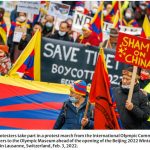Robert Barnett for Foreign Policy
In April 1998, with the Himalayan passes still more than 6 feet deep in snow, Penpa Tsering, a 22-year-old Tibetan herder, set off to the south from his home in Tibet across a remote 15,700-foot-high pass called the Namgung La. He was leading a train of a dozen yaks carrying tsampa (parched barley flour), rice, and fodder.
Penpa Tsering had been dispatched by the village leader of Lagyab, a settlement in Lhodrak county nearly 7 miles northeast of the Namgung La as the crow flies, to take desperately needed supplies to four other Tibetan herders who were spending the winter in a remote grassland area at 14,200 feet on the south side of the pass. Without the food that Penpa Tsering’s yaks were carrying, the herders would not survive the winter. After one day and one night of walking, Penpa Tsering reached his fellow herders and saved their lives. They later said they had expected to die. But Penpa Tsering never made it back to Lagyab: He died in an avalanche as he tried to find his way back across the pass.
In the Chinese media reports on which this account is based, Penpa Tsering’s death is presented as an act of martyrdom, a minor figure in the pantheon of China’s model citizens. His sacrifice, however, was unnecessary. The men he saved were overwintering in the high pasturelands not to improve their lives or to help their flocks but as pawns in an imperial project designed and driven by politicians in Beijing, 1,600 miles away. Today, that project has expanded into a vast network of quasi-militarized settlements along—and sometimes across—China’s Himalayan borders. Its purpose is to strengthen China’s geopolitical position in the region; it has little or nothing to do with the welfare or interests of the herders. But it cannot function without them.
Click here to read the full article











